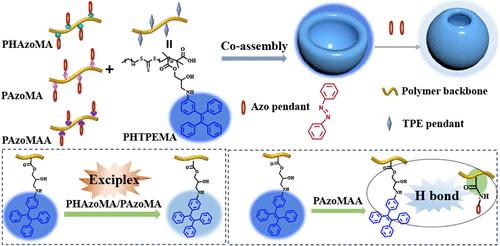Morphology Regulation and Quenching Mechanism of AIE Nanobowls by Side Chain Engineering of Azobenzene Homopolymers
IF 5.2
1区 化学
Q1 POLYMER SCIENCE
引用次数: 0
Abstract
The precise regulation of the luminescent properties of fluorophores by molecular engineering strategies has evolved into a crucial method for constructing intelligent photoresponsive nanomaterials. However, the factors influencing the fluorescence quenching efficiency and the mechanism of aggregation-induced emission (AIE) nanoparticles are still unclear. In this study, a series of amphiphilic azobenzene homopolymers with different side chains containing ether, amino, and amide bonds were synthesized, and the linkage has a significant impact on the UV–vis absorption of azobenzene. When coassembled with a tetraphenylethylene (TPE)-containing homopolymer, nanobowls with controlled size and openings were formed, and the fluorescence of TPE was quenched due to the inhibitory effect of azobenzene. It was found that the opening size of the nanobowls decreased with the increase of azobenzene content, and the quenching efficiency derived from the intensity of the amide-bonded azobenzene homopolymer was 10 times higher than that of the others due to the formation of hydrogen bonds. While the quenching efficiencies of the ether- and amino-bonded azobenzene homopolymers were quite low, owing to the red-shift of the emission wavelength induced by the formation of exciplexes. Overall, a hydrogen bond-enhanced fluorescence quenching mechanism is proposed, and the formation of exciplexes in polymeric nanoparticles is also observed and verified, providing a fresh perspective for an in-depth understanding of the quenching mechanism of fluorophores by chromophores.

偶氮苯均聚物侧链工程对AIE纳米碗形貌的调控及猝灭机理
通过分子工程策略精确调控荧光团的发光特性已经发展成为构建智能光响应纳米材料的重要方法。然而,影响AIE纳米粒子荧光猝灭效率的因素和机理尚不清楚。本研究合成了一系列两亲性偶氮苯均聚物,其不同侧链含有醚键、氨基键和酰胺键,该键对偶氮苯的紫外-可见吸收有显著影响。当与含四苯基乙烯(TPE)的均聚物共组装时,形成了具有控制尺寸和开口的纳米碗,并且由于偶氮苯的抑制作用,TPE的荧光被猝灭。结果表明,随着偶氮苯含量的增加,纳米碗的开口尺寸减小,并且由于氢键的形成,酰胺键偶氮苯均聚物的淬灭效率比其他均聚物高10倍。而醚键偶氮苯和氨基键偶氮苯均聚物的猝灭效率很低,这是由于杂络合物的形成引起了发射波长的红移。综上所述,本文提出了氢键增强的荧光猝灭机制,并对聚合物纳米颗粒中杂络合物的形成进行了观察和验证,为深入理解发色团对荧光团的猝灭机制提供了新的视角。
本文章由计算机程序翻译,如有差异,请以英文原文为准。
求助全文
约1分钟内获得全文
求助全文
来源期刊

Macromolecules
工程技术-高分子科学
CiteScore
9.30
自引率
16.40%
发文量
942
审稿时长
2 months
期刊介绍:
Macromolecules publishes original, fundamental, and impactful research on all aspects of polymer science. Topics of interest include synthesis (e.g., controlled polymerizations, polymerization catalysis, post polymerization modification, new monomer structures and polymer architectures, and polymerization mechanisms/kinetics analysis); phase behavior, thermodynamics, dynamic, and ordering/disordering phenomena (e.g., self-assembly, gelation, crystallization, solution/melt/solid-state characteristics); structure and properties (e.g., mechanical and rheological properties, surface/interfacial characteristics, electronic and transport properties); new state of the art characterization (e.g., spectroscopy, scattering, microscopy, rheology), simulation (e.g., Monte Carlo, molecular dynamics, multi-scale/coarse-grained modeling), and theoretical methods. Renewable/sustainable polymers, polymer networks, responsive polymers, electro-, magneto- and opto-active macromolecules, inorganic polymers, charge-transporting polymers (ion-containing, semiconducting, and conducting), nanostructured polymers, and polymer composites are also of interest. Typical papers published in Macromolecules showcase important and innovative concepts, experimental methods/observations, and theoretical/computational approaches that demonstrate a fundamental advance in the understanding of polymers.
 求助内容:
求助内容: 应助结果提醒方式:
应助结果提醒方式:


